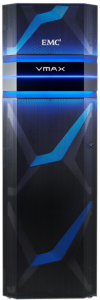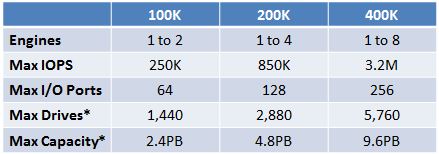 Today, as part of their “MegaLaunch”, EMC announced the next generation of their VMAX storage platform. The new line is known as the VMAX3 and consists of three models, the 100K, 200K, and 400K which succeed the previous generation’s 10K, 20K, and 40K VMAX2 models respectively.
Today, as part of their “MegaLaunch”, EMC announced the next generation of their VMAX storage platform. The new line is known as the VMAX3 and consists of three models, the 100K, 200K, and 400K which succeed the previous generation’s 10K, 20K, and 40K VMAX2 models respectively.
According to EMC, the new VMAX3 models provide:
- Up to 3X the IOPS
- Up to 3X the bandwidth
- 2x the number of logical devices
- More than 2X the number of front-end I/O ports
- 6X the IOPS per floor tile
- 2X the TB per floor tile
as compared to the older VMAX2 models.
Due to a combination of increased performance and greater storage density, VMAX3 also offers the ability to house a greater number of virtual machines per system than the VMAX2. Comparisons are shown in the graphic below. (Numbers are based on the assumption of 100IOPS and 100GB per VM, with datastores using thin LUNs.)
Specs for the new models are in the table below:
* Reaching the maximum number of drives, and therefore the maximum capacity, will require updates to the VMAX3 software that won’t be available until 2015.
In addition to updating the specs of the platforms, the VMAX3 adds several new features, which I detail below.
Dynamic Virtual Matrix
The new architecture of the VMAX3 allows the engines easier access to each other’s cache and CPU resources. The engines are built using multi-core processors and are designed for scale-out of the CPU resources. It’s the Dynamic Virtual Matrix that provides the VMAX3 its ability to do dynamic resource allocation (more on that later).
Hypermax OS
The VMAX3 runs a new operating environment called Hypermax OS, not the Enginuity operating environment that runs on the VMAX2. The new software provides for a number of new features.
Array management is different with Hypermax OS. VMAX3 can be managed by EMC Unisphere, which will be familiar to VNX users, or by EMC ViPR.
VMAX2 is a block-only platform. With Hypermax OS, the VMAX3 offers not only both block and file protocols, but also allows for connection to cloud gateway services.
Lastly, Hypermax OS has deeper integration with other offerings in the EMC portfolio:
- for management, integration with ViPR
- for data mobility, integration with VPLEX
- for backup, integration with Data Domain
- for data protection, integration with RecoverPoint
SNAPVX
VMAX3 adds a new feature called SNAPVX, which provides what EMC refers to as “hybrid cloud scale” snapshots. Unlike older VMAX snapshots, SNAPVX snaps don’t require the use of a dedicated snapshot reserve volume.
SNAPVX allows for up to 1,024 snaps per individual source. EMC claims the new snapshots have negligible effect on performance.
The Shift
The message with VMAX3 is about planning for and managing to meet Service-Level Objectives (SLO).
This is a shift from older VMAX’s (I have no idea what the proper plural is. “VMAXes”? “VMAXen”?). In the past, storage administrators have managed VMAX for capacity. They will manage the VMAX3 for performance.
By taking advantage of EMC’s Fully-Automated Storage Tiering (FAST), VMAX3 will be able to dynamically adjust given volumes’ service levels, adjusting for both IOPS needed and acceptable latency.
New Bezel
 In keeping with recent EMC tradition, in addition to all of the above, the VMAX3 also comes with the cool new bezel shown on the right.
In keeping with recent EMC tradition, in addition to all of the above, the VMAX3 also comes with the cool new bezel shown on the right.
Availability
The new VMAX3 units will start shipping in late August. Some features will not be available until later. For example, Data at Rest Encryption (D@RE) is due to be added in late Q4, and the software updates that will allow expansion to the full number of disk drives is due in early 2015.



Pingback: EMC Redefine Possible (TL;DR Edition)
Pingback: EMC VMAX3 in 3D |
Pingback: Most-Read GeekFluent Posts in 2019 | GeekFluent